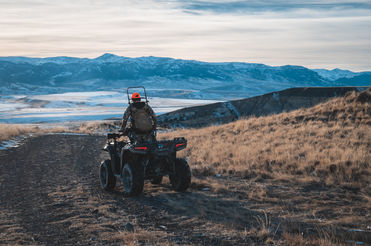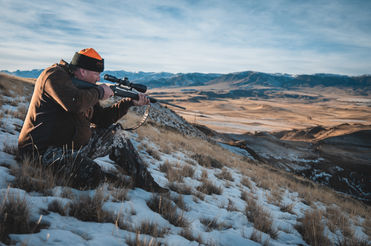

Hunting
Hunting is a very common and accepted practice in Wyoming, something most residents have been familiar with since childhood. However, there are different reasons and motivations for hunting. First, it is a cheap source of meat for many locals. For instance, an elk cow tag costs a resident around $50, yielding around 170 pounds of meat. But of course, for most, hunting is more than just "to put food on the table." It's an event where family and friends come together, share adventures, and create collective memories that will be told over and over again throughout life. Furthermore, there is trophy hunting, which attracts many hunting tourists from other parts of the country and around the world. Popular trophies are elk, big horn sheep or mountain lion. To hunt big game animals, including antelope, whitetail deer, mule deer, elk, bighorn sheep, moose and mountain goats, you need a license in Wyoming - a so-called tag. To obtain a tag, you must apply to the Game & Fish department within a certain period of time. The application must specify the species, the type (female/male) and the hunting area. Afterwards the tag for the different animal species and hunting areas are drawn by lot. There are different seasons for the different species. For example, the hunting season for black bear is in spring and fall, whereas most other animals, such as deer, antelope, or moose are hunted exclusively in the fall. Elk is hunted during fall and winter.
Elk Hunting
Elk hunting is extremely popular in Wyoming. On the one hand, the animals offer a lot of tasty meat. On the other hand, the bulls with their large antlers are very desired trophies. Elk are very intelligent and have highly developed senses, which makes hunting very demanding and challenging. Most locals, who do not own their own land, hunt on public land that is accessible without a permit. Others ask the many ranchers to hunt on their properties. Hunting tourists who lack knowledge of the land and animals use the services of a so-called outfitter. The outfitter organizes the hunt and provides guides who are familiar with the animals and the land. This doesn't come cheap, and a 5-day elk hunt with accommodation can easily cost between $5-10,000. But even with the right knowledge, elk hunting is quite a challenge, and success also depends on factors such as weather, terrain and population density. I have had the opportunity to participate multiple times in an elk hunt. In most cases, however, the hunters were not successful.
Trophies
Trophies, such as antlers or different kinds of mounts, can be found almost everywhere. Whether in private homes, restaurants and hotels or other places. They are a common part of everyday life. The art of preserving an animal body via mounting is called taxidermy. Some hunters who have the right knowledge make their mounts themselves, but most have them made by a professional taxidermist. In the past, the form onto which the tanned hide is pulled had to be made by the taxidermist himself. Today, there are several companies that offer ready-made forms for all kinds of animals in different poses, which makes the work much easier and less expensive.
Now there are several reasons why people want to display trophies. Without going into too much detail, as it is a very complex topic, one reason is certainly that the trophy serves as a memory. Like a photography or other material things, looking at the trophy brings back to mind a certain experience, an adventure that is fondly remembered. Another reason is certainly the display of one's skill and greatness as a hunter, as well as prestige, wealth and masculinity.
Antilope Hunt
Hunting antelope, or pronghorn, is certainly one of the "easier" hunts. The animals exist in large numbers and in their habitat, the vast prairie, they can be seen from far away. The animals are relatively small and therefore yield only around 30-40 pounds of meat. However, people here are divided on the taste of the meat. Some find it extremely appealing, others would not eat a bite. The name antelope is deceptive, because the animals are not an antelope, even if they visually resemble the African and Asian antelopes very much. Rather, they form a completely separate family, the Antilocapridae, of which they are the only representative. The horns of the males are popular hunting trophies and one can find a mounted head in many local homes.
































